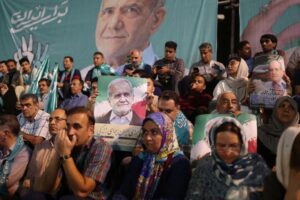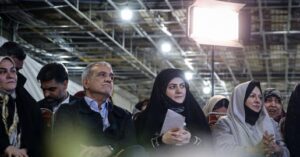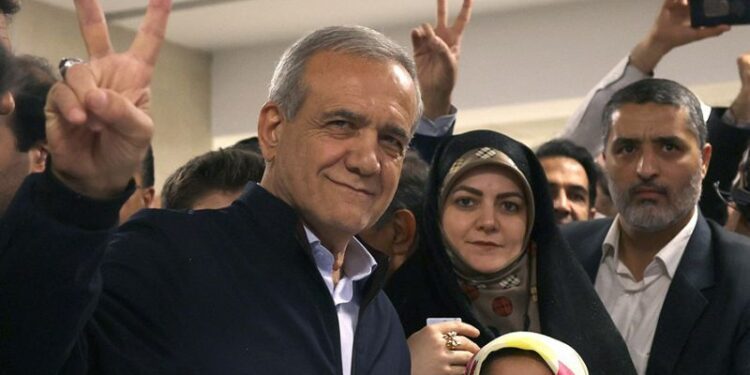On July 5, heart surgeon and reformist Masoud Pezeshkian secured victory as Iran’s 9th president in a closely contested runoff against conservative Saeed Jalili. The Iranian Interior Ministry reported a 49.8 percent turnout with 30,530,157 votes cast, of which Pezeshkian garnered 53.6 percent—making him the second president with the lowest percentage of votes since Hassan Rouhani in 2013. It is clear that Masoud Pezeshkian, Iran’s New President Vows More Freedom Improved Western Relations.
A Reformist Championed by Minorities

Pezeshkian represents Iran’s Reform Front, a political movement that gained prominence in 1997 with Mohammad Khatami’s presidency. He also enjoys support from the Moderate faction led by former president Rouhani. Despite the Reformists’ past victories, their influence dwindled over the past two decades. Pezeshkian’s win, attributed significantly to Iran’s ethnic and religious minorities, underscores this shift. Notably, Pezeshkian is the first president of neither the Fars ethnic majority nor the central Farsi-speaking provinces.
His electoral success was bolstered by the mobilization of ethnic Iranian Turks, or Azeris, in the northwestern provinces. Turkish President Recep Tayyip Erdogan expressed hope that Pezeshkian’s ethnic roots and proficiency in Turkish would strengthen Iran-Turkiye ties. Similarly, Pezeshkian’s maternal Kurdish background garnered support in the predominantly Sunni provinces of Sistan-Baluchestan, Golestan, and Kurdistan.
Transition and Cabinet Formation
Iran has been without a president for over seven weeks since Raisi’s passing, with Vice President Mohammad Mokhber temporarily managing the government. Pezeshkian, still a parliamentary lawmaker, must resign from his seat with the Majlis’ approval before taking office. The Iranian parliament will discuss his resignation in late July, and if approved, Pezeshkian will be sworn in and will chair Raisi’s cabinet while introducing his own lineup for a vote of confidence, expected in September.
Pezeshkian faces the significant task of assembling a team of 40 key officials, including ministers and deputy presidents. The Iranian Constitution requires the Supreme Leader’s approval for critical ministers such as Defense, Intelligence, Interior, and Foreign Affairs, but presidents often consider the leader’s input for other ministries as well.
Women in the Pezeshkian Administration

The appointment of women in ministerial positions remains a contentious issue. While former presidents like Ahmadinejad appointed female ministers and deputies, reformists like Rouhani and Raisi did not appoint women to ministerial posts. Pezeshkian has not yet mentioned women in his cabinet, and the number of female ministers will be a litmus test of his commitment to addressing women-related issues, such as the Islamic Hijab and the morality police.
New President, New Foreign Policy?
During his campaign, Pezeshkian expressed a willingness to shift Iran’s foreign policy, review relations with Russia, and restore ties with the US. However, Supreme Leader Khamenei has warned against over-reliance on the West. Analysts like Talal Mohammad doubt significant changes in the status quo, given the entrenched power structures and the looming possibility of Donald Trump’s return to the US presidency, which could reintroduce stringent policies against Iran.
Tehran-based Political Science lecturer Keyhan Barzegar suggests that while the president can influence negotiation methods, the Supreme National Security Council (SNSC) and Khamenei determine the overall direction of foreign policy. Barzegar advises Pezeshkian to advocate for regional stability to enhance Iran’s strategic importance and attract global support, potentially easing sanctions and increasing foreign investment.
In his post-election message, Khamenei advised Pezeshkian to trust in God and follow the path set by Martyr Raisi. Despite having former foreign minister Javad Zarif as an advisor, Pezeshkian is likely to adhere to the state-outlined foreign policy rather than pursuing a more conciliatory stance independently.
Strategic Partnerships
Pezeshkian’s presidency comes at a time when Iran’s strategic partnerships are under scrutiny. The country has strengthened its ties with China and Russia since the invasion of Ukraine, with China providing significant economic support to Russia. Pezeshkian’s stance on international relations, especially his willingness to engage with the West, could potentially alter these dynamics.
The Road Ahead
As Pezeshkian steps into his new role, the world watches closely. His promises of reform and improved international relations offer hope to many Iranians, but the true test will be whether he can navigate the entrenched power structures and deliver on his commitments.
Key Questions
- What are the potential implications of strengthened Iran-West relations under Pezeshkian’s presidency?
- Strengthened relations could lead to the easing of economic sanctions and improved economic conditions in Iran. However, this may cause friction with hard-line factions within the government and with allies like China and Russia.
- How has Pezeshkian’s election been received by Iranian society and international observers?
- Reactions are mixed. Some see his election as a step towards necessary reforms, while others, like Marjane Satrapi, are skeptical about the possibility of meaningful change under the current regime.
- What role will women play in Pezeshkian’s administration, and what does this signify for gender equality in Iran? Examining prospects for female representation in ministerial positions and the implications for women’s rights and societal norms in Iran.
- To what extent can Pezeshkian’s economic policies alleviate Iran’s economic challenges, including inflation and unemployment? Assessing the effectiveness of Pezeshkian’s proposed economic reforms and their potential impact on Iran’s economic stability and growth.
- How will Pezeshkian approach Iran’s international alliances and partnerships, particularly with China and Russia? Investigating whether Pezeshkian’s presidency will lead to a reevaluation of Iran’s strategic alliances and economic partnerships with major global powers.
Masoud Pezeshkian’s election marks a significant moment in Iran’s political landscape. While his promises of reform and improved international relations offer hope to many, the true impact of his presidency will depend on his ability to navigate the complex power structures within the Islamic Republic. The coming months will reveal whether Pezeshkian can fulfill his campaign promises and bring about meaningful change in Iran.
Related stories:
Who is Masoud Pezeshkian, the New Iranian President?
Iran Approves Six Presidential Candidates After Raisi’s Death
Young Iranians’ Divergent Views on 2022 Protests Shape Presidential Race
Thousands Mourn President Raisi After Tragic Helicopter Crash Amid Iran’s Political Crisis
Who is Mohammad Mokhber, Iran’s Interim President?
Iranian President Ebrahim Raisi Dies in Helicopter Crash at 63
















